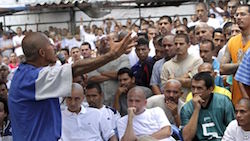The conclusions of a recent study examining the outcomes of gang truces in Latin America suggest a new peace agreement between the Barrio 18 and MS13 in El Salvador may only lead to increased violence in the long term.
The study (pdf), conducted by Arizona State University and El Salvador’s National Foundation for Development (FUNDE), evaluates the conditions under which gang truces occur, the role of negotiators, and the short- as well as long-term effects of the agreements. Using the case studies of El Salvador, Honduras, and Jamaica, the authors found several common conditions that led to a gang truce:
1) Communities had been experiencing an “uncharacteristically high number of gang-related homicides” over an extended period of time, which put pressure on the government to take action.
2) Attempts at controlling gang violence through suppression-oriented strategies had failed.
3) The government’s inability to decrease violence had become readily apparent, leading state and community leaders to seek “an alternative strategy in which negotiators would formally and/or informally work directly with gang leaders to establish a truce.”
4) Key stakeholders in El Salvador, Honduras, and Jamaica played similar roles in negotiations. Gang leaders were willing participants in the process and sought to collaborate with negotiators — typically a small group of individuals perceived to be “honest brokers.”
However, strategies on how to implement the respective truces differed. These differences were primarily related to how negotiators and the gangs identified common goals and “tangibles that could be delivered to the gang in exchange for the gang achieving the stated goals.”
In El Salvador, negotiators secured promises of immediate changes in gang behavior (i.e., violence reduction). In exchange, imprisoned gang leaders were relocated to less-restrictive prisons. Following this short-term success for both parties, broader, more long-term issues could be negotiated on a stronger footing.
In Jamaica and Honduras, however, gang leaders asked for long-term government and social changes in exchange for an immediate reduction of violence. Neither country could deliver the gangs’ demands in a short time frame, suggesting the importance of quick and easy results in order “to achieve trust and serve as a first test of gang leaders’ ability to deliver.” The study found the gang truces in Jamaica and Honduras had no short- to medium-term impact on overall violence, and attributed the decline in homicides to broader trends in these countries.
In contrast, the authors found the gang truce in El Salvador was as an effective short-term strategy for reducing homicides. The truce saved an estimated 5,500 lives between March 2012 and June 2014, according to the report.
SEE ALSO: El Salvador News and Profiles
While the authors regard the gang truce in El Salvador as a short-term success, they found it appears to be an isolated case, and cautioned policymakers considering a gang truce to be aware of the potential for long-term negative consequences — which could outweigh any potential benefits in the near term.
InSight Crime Analysis
Gang truces are a controversial undertaking, the benefits of which — as this new study suggests — are mixed and open to competing interpretations. Perhaps the best example of this is the heated debate over whether or not El Salvador’s government should re-start negotiations with the country’s principal street gangs, the Barrio 18 and MS13.
Initially, El Salvador’s gang truce led to a dramatic drop in homicides — leading neighboring nations Guatemala, Honduras, and Belize to consider and pursue similar arrangements in the hopes of replicating El Salvador’s success. In late 2013, however, the truce began to unravel and violence started rising, reaching epidemic levels during the first half of 2015.
SEE ALSO: Coverage of El Salvador gang truce
Recently, Salvadoran gang leaders have called for a reinstatement of the truce, asking for a “mechanism” that allows for dialogue and an eventual peace agreement. In essence, the gangs are giving authorities a high-stakes ultimatum by refusing to reduce violence until the government comes to the negotiating table.
Nonetheless, the findings of the ASU-FUNDE study cast doubt on the wisdom of initiating a second gang truce in El Salvador.
On the one hand, El Salvador is undoubtedly experiencing two of the conditions the study suggests should be met before a gang truce can be struck: high levels of gang violence and limited government capacity for social control.
SEE ALSO: Coverage of Security Policy
Yet is is unclear to what extent the MS13 and Barrio 18 leadership can control its members and deliver immediate benefits such as a reduction of violence. The gang leaders have been transferred back to a maximum-security prison facility, ostensibly limiting their ability to coordinate and exert control over the day-to-day activities of members on the street. Furthermore, gang leaders reportedly agreed to halt violence in early 2015, yet El Salvador just experienced the two deadliest months the country has seen since its civil war.
Another gang truce also heightens the potential for increased violence in the long term, similar to how murder rates in El Salvador have been soaring since the breakdown of the first truce. A second gang truce thus raises the possibility of a cyclical effect, with periods of lowered homicide rates punctuated with periods of extreme violence.

